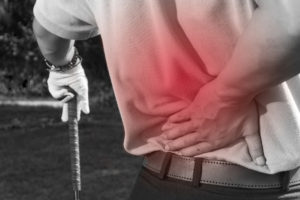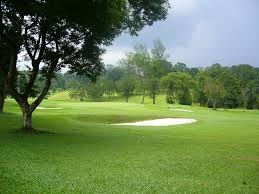 The unique twisting motion of the golf swing can cause injuries from head to toe. Here’s a rundown of some common golf injuries and tips on how to avoid them.
The unique twisting motion of the golf swing can cause injuries from head to toe. Here’s a rundown of some common golf injuries and tips on how to avoid them.
Neck
As you swing, that twisting motion can lead to spasms, chronic neck pain and even pinched nerves. The more you swing, the worse it gets. Warming up with neck exercises before you practice or play will increase strength and flexibility – and reduce your risk of injury.
Shoulders
It’s no surprise that shoulder injuries are common among golfers. Strength training and adjustments to your swing can help you avoid tendonitis, bursitis and rotator cuff injuries. Don’t forget to handle your golf bag with care; just yanking those heavy clubs out of the car can injure your back or shoulder.
Elbows
Golfer’s Elbow is a painful irritation and inflammation of the outer or inner elbow tendon. This can result from repetition – or even from hitting the ground instead of the ball. Moderation is key. Don’t wait until you feel pain to call it a day.
Wrists and Hands
Wrist and hand injuries are often caused by repetitive movement. Wrist Tendonitis is a common and painful injury which can take months to heal. Learning the proper grip and avoiding long practice sessions can help you avoid wrist and hand injuries.
Back
Back pain is frequently seen in golfers. Whether you’re swinging a golf bag or a golf club, herniated or slipped discs, muscle strain and ligament damage are all “par for the course.” It’s best to schedule a doctor’s visit for any type of back pain. What seems like a minor problem could be an indication of a larger medical problem. Warm ups and strength exercises can help prevent back injuries.
Hip
The pivoting motion of repeated golf swings is hard on the hips and can result in hip injuries similar to rotator cuff tears. Taking time to warm up, and incorporating a regimen of exercises that build strength and flexibility, can help you support the muscles that surround the hip joint and prevent painful and disabling injuries.
Knee
Uneven ground, a poor stance and the stress on your knees during the golf swing can all contribute to knee injuries. Our knees really aren’t designed for the rotation and side-to-side movement required to swing a golf club successfully. To help protect your knees, follow an exercise plan designed to keep the muscles in your hips, lower back, and mid back flexible and also strengthen the muscles around your knee joint.
Ankles and Feet
Ankle sprains, plantar fasciitis, Achilles tendonitis, swollen feet and blisters are all common golfing injuries. Proper shoes and strengthening exercises will help you stay on your feet without pain or injury.
Take proactive steps to prevent pain and injury
Your swing is everything!
Proper technique will not only improve your game, it can help prevent painful and potentially serious injuries. Without it, the stress you place on your body is likely to lead to discomfort and pain.
Know when to stop!
Adjusting your technique to “play through the pain”, doesn’t work. You’ll just transfer the same physical stresses to other areas of your body and increase your chances of multiple injuries and even more pain.
More than an ounce of prevention
A regimen of preventative measures like warming up, wearing the right shoes, strength exercises and learning the proper swing technique will help you avoid injuries and concentrate on enjoying the game. Check out these tips from the Mayo Clinic for proactive steps you can take to avoid painful golf injuries.
Know when to call you doctor
As always, you need to “listen” to your body. Sometimes personal prevention or mediation measures don’t do the trick. We are always available to answer your questions and if your pain does not improve, or gets worse, you should be in touch with a doctor. Feel free to reach out HERE if you would like to have your questions answered, or if you need to make an appointment.

